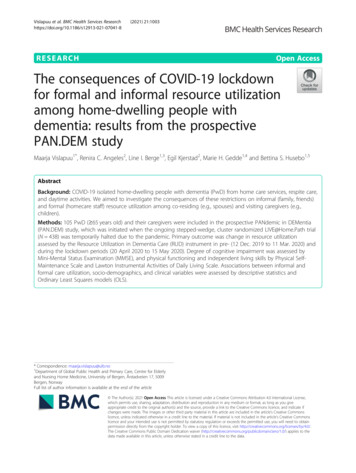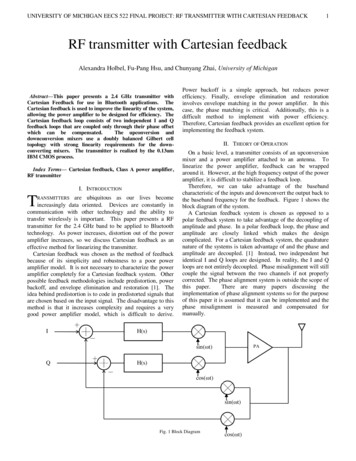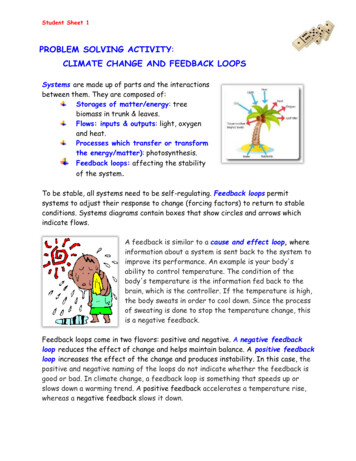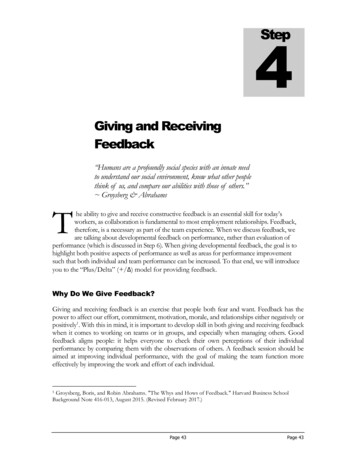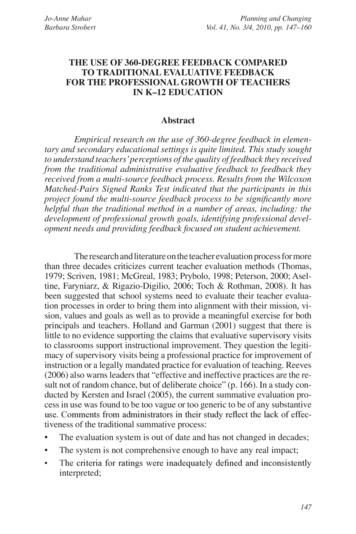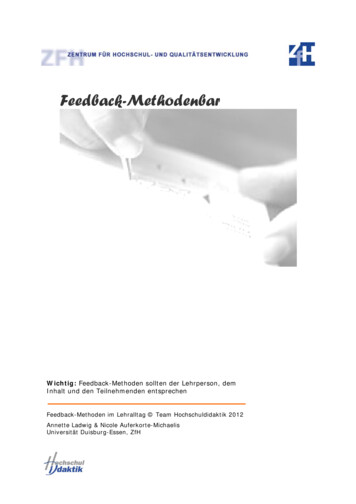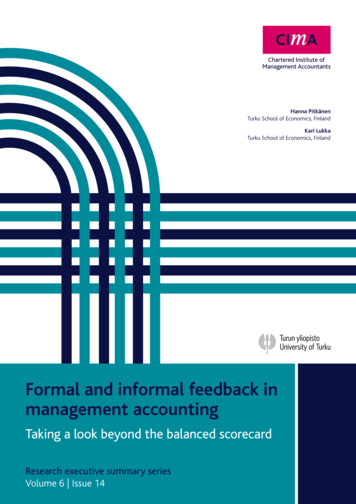
Transcription
Hanna PitkänenTurku School of Economics, FinlandKari LukkaTurku School of Economics, FinlandFormal and informal feedback inmanagement accountingTaking a look beyond the balanced scorecardResearch executive summary seriesVolume 6 Issue 14
Key conclusions: Formal and informal feedback plays a key part in influencing how effectivelyorganisations are managed. Formal and informal feedback does not form a black and white dichotomy withstrict boxes, but is a continuum with a grey area in between. The power of modern models, such as the Balanced Scorecard (BSC), to balancefeedback is questionable and does not detract from the relevance of informalfeedback. Viewing feedback along three dimensions: source, time, and rule – can helpmake sense of the various interpretations of formal and informal feedback inorganisations. In large organisations, especially middle managers are key to keeping vertical chainsof feedback going. The challenge is for managers not to rely solely on systemsbased, formal accounting feedback in decision making.
Executive summaryDrawing on a case study with interviews of twenty seniorand middle managers in a large metal industry company,we call for a shift in focus from systems per se towards anincreased use of feedback practices.it is untimely, unreliable, too general, or limited formanagers. Since those times, the area of formal feedbackin organisations has developed with more transparent andcomparable information and management systems. The BSCby Kaplan and Norton (1992, 1996) has been marketed as acomprehensive, holistic, and multidimensional measurementframework. It aims to quantify processes and stresses therole of formal performance measures. While the balancedscorecard can be viewed to encompass informal feedbackthrough new kinds of measures, it is unclear what the role ofinformal feedback is in organisations.In management accounting, feedback has traditionally beenviewed rather mechanistically - as a formal control loopbetween goals and measured performance using formalaccounting and information systems, such as the balancedscorecard (BSC). We suggest feedback should be consideredas a wider concept, one that includes many types offeedback flows, both formal and informal, which all influencehow effectively organisations are managed towards commongoals.We therefore question whether a strong link betweensystems and contemporary feedback practices exists.Managers are not simply passive recipients of measuredfeedback - they also seek additional feedback actively.The ability to produce and use both formal and informalfeedback efficiently depends on the skills and abilities ofmanagers and the organisation’s history and culture. Informalfeedback is therefore an inherent part of feedback practicesin organisations.The subject of formal and informal feedback, in the contextof management accounting, is broad and diverse. Wetherefore propose a three-dimensional framework as a toolfor discussing different views on the subject.Conceptualising feedbackMost contemporary organisations and societies are facedwith a common paradox: information systems are constantlyimproving and users are receiving more and more systemsbased information but still they suffer from the inability toget sufficient personal feedback. Why is this?IntroductionWith the help of performance measures, managers receiveand use feedback to assist organisations to achieve theirgoals, implement their strategies, and learn. Diagnosticcontrol systems, like budgets and performance measures,aim to ensure predictable goal achievement with correctivefeedback by comparing and calculating deviations betweenactual performance and preset goals or standards. Resultsfrom the output provide formal numerical feedback (outputfeedback) on how well an organisation is achieving itsstrategic, operational, and financial goals.In management accounting, feedback has been studiedmainly in the context of performance measures (i.e. formalfeedback). Scorekeeping, attention-directing, diagnostic andinteractive control systems are well-known examples offormal feedback. This discussion is based mainly on systemsthinking and on cybernetic control theory. From a cyberneticviewpoint, feedback is regarded as a signal, a mechanism, anda process controlling the system within itself.Already from the 1970’s, management accounting literaturehas pointed out several limitations in formal systems’ability to produce relevant and adequate information:Theoretically, the concept of feedback as distinct frommere information requires goals, standards, or forecasts(explicit or implicit, organisational or personal) againstwhich actions, operations, and changes in the environmentcan be compared (ex post) or evaluated (ex post or ex ante).Feedback can be analysed either at the: organisation level, focusing on output or person level, focusing on individual performance.At the organisation level, output feedback can take the formof performance reports, organisation wide key performanceindicators, or information about competitors’ performance.At the person level, feedback is described in terms ofbehaviour, motivation, learning, and communication betweensuperiors and subordinates.In management accounting literature, feedback as a responseto the variance between performance and goals can beviewed rather broadly:Goal achievementFeedback helps to control units by tracking theirdevelopment. In case of observed deviations between presetgoals and actual outputs, feedback is used to align actionswith the intended level of performance.1 Formal and informal feedback in management accounting - Taking a look beyond the balanced scorecard
Goal congruenceFeedback directs and motivates individual behaviour towardsorganisational goals. For example, in performance appraisalinterviews, evaluative feedback from the manager as wellas monetary and social rewards assist in working towardsshared common goals.Goal revisionIndividuals and organisations use feedback to make changesand learn in order to improve their performance. Feedbackhelps to direct attention to relevant issues not only in thepast but also in the future.Goals can be also in the form of future forecasts. Althoughfeedback is considered primarily an ‘ex post’ control device, itcan be interpreted either in a narrow or broad sense havingboth backward directed and forward directed loops in termsof time. In the traditional narrow meaning, feedback is seenonly as a backward directed comparative between actualperformance and pre-set goals with deviations revealing theneed for actions (‘ex post’ control with output feedback).From a broader viewpoint, feedback can also be consideredas future directed ‘feed-forward’ information, which canbe used to forecast the need for actions before observeddeviations occur in the environment (‘ex ante’ control withinput feed-forward).In practice, various kinds of feedback loops often operatesimultaneously: for example, rolling budgets include bothmonitoring of actual outcomes (‘ex post’) as well as planningand future forecasts (‘ex ante’). Therefore, we use the termfeedback in accordance with the broad interpretation.Feedback loops, whether operating as ‘ex post’ or ‘ex ante’,may take place both formally and informally, even thoughformalising future directed processes are usually regarded ashighly challenging.Conceptualising formal and informal feedbackEarlier literature provides various interpretations of formaland informal feedback. We offer three dimensions – source,time, and rule (see figure 1) – as an analytical tool to makesense of the various interpretations of formal and informalfeedback.Figure 1. Different definitions of formal and informal feedback from the literature reviewFormal feedbackInformal feedbackDimensionLondon (2003)Formal appraisals,performance reviews, ormeetings with superiorsCommunicated in everydayinteractions, individualfeedback seeking behaviourSource, Time, RuleLuckett and Eggleton(1991)Feedback provided throughmanagement accountingsystems (MAS)Provided throughsocial sources such assuperiors, peers, task, andself (person-to-personfeedback)SourceLondon and Smither (2002)Provided through formalmechanismsProvided independently offormal mechanismsSourcePlanned, officially definedfeedbackUnplanned or ‘in themoment’ feedbackTime, RuleKatz and Kahn (1978)Scheduled feedbackUnscheduled feedbackTimeAshford and Tsui (1991,253)Requisite feedback (e.g.formal performanceappraisal systems, formalmeasurement systems, andformal communicationamong managers)Unsolicited feedbackRule, Source2 Formal and informal feedback in management accounting - Taking a look beyond the balanced scorecard
Source dimension. First, the literature distinguishes formaland informal feedback along pathways through whichfeedback flows. For example, formal feedback consists offormal performance reviews or meetings whereas informalfeedback is communicated in everyday interactions orindependently of formal mechanisms.Time dimension. Formal feedback is planned beforehandand systematically scheduled into the official procedures ofthe organisation. Instead, the nature of informal feedbackcan be accentuated as taking place in everyday interactions,as an unplanned or spontaneous event, or ‘in the moment’feedback.Rule dimension. Formal feedback can be related tomandatory routines and communication derived fromthe hierarchical relationship between managers and units.Informal feedback is associated with unsolicited feedback, i.e.any feedback perceived to be voluntary by the managers.Research settings and methodsOur research is based on a qualitative case study of DivisionSteelco, which is the oldest division out of four of a large,global firm operating in the metal industry. Data wascollected mainly through twenty semi-structured thematicinterviews, recorded and transcribed between September2007 and February 2009. We interviewed senior and middlemanagers of Division Steelco’s local operations in Finland andalso a few senior managers from the corporate headquarters.This provided an overview of the general managementsystem of the group as well as relations between theheadquarters and Division Steelco’s local units. Interviewswere supported by analysis of official documents, internalrecords received from the interviewees, observations duringthe interviews, and in numerous informal situations, such asfactory visits and lunches.Flows of formal and informal feedback inmanagement accountingIn previous management accounting literature, formalcontrols were typically seen as system-based structures,while informal controls were based on social structures thatcould be assumed to produce feedback. This is only a part ofthe story in our view:System-based feedback (formal) is linked to accountingand information systems. Performance data is codifiedinto systems and can then be given and received withoutinterpersonal communication. The formalisation of feedbacksources assures a certain minimum level of feedback isgiven everywhere, which makes individual preferences anddifferences between managers less crucial.Interpersonal feedback (informal) is given between twoor more people allowing a broader scale of themes andquestions to be dealt with. Examples of feedback practicesthat involve interpersonal feedback are; performanceappraisal interviews, management group or team meetings,and other communication between managers, employeesand peers. Feedback communicated in human interactionis linked to the people involved and the context. Thereforeit may stay only at a local level and cannot be used moresystematically in the whole organisation. One of theadvantages is that it allows a broader scale of feedback loops,such as non-verbal communication and body language.Thus, all feedback channels provide a variety of differentelements of feedback - both formal and informal.Timing of feedbackTime dimension is suitable for considering formal andinformal feedback in relation to when certain flows offeedback operate.Regular feedback (formal) in the form of ongoing reportingof results gives managers a comparable time series withwhich to follow trends and analyse the changes overtime. The feedback is planned beforehand and operatessystematically over certain periods. For example, keyperformance indicators are followed month after month orquarter after quarter.Irregular feedback (informal) – a lot of feedback ineveryday life is something that just emerges spontaneouslyin the moment or during action. Irregular feedback allowsfaster responses to changes and assists in daily managementand real-time decision-making. For example, managers mayask for controllers to prepare an ad hoc report because ofalarming changes in a certain market, product, or customersegment.Rules of feedbackSource of feedbackAccording to the widely used distinction in previousmanagement accounting literature, accounting informationsystems and interpersonal communication are usedto illustrate formal and informal feedback practices inorganisations.Rule dimension is suitable for considering formal andinformal feedback in relation to why certain flows offeedback are provided.Requisite feedback (formal) is based on coercivehierarchical communication between managers andemployees, e.g. in the form of producing monthly3 Formal and informal feedback in management accounting - Taking a look beyond the balanced scorecard
performance measures for the headquarters or standardprocedures for performance appraisal interviews.Unsolicited feedback (informal) is any feedback perceivedas voluntary and additional. This is connected to personalabilities, styles, and preferences to offer and receive feedback.Managers’ attitudes towards feedback practices affect theway additional feedback is given.According to our empirical findings, the existence of ahierarchical relationship may transform informal ad hocsituations into formal feedback situations. This may occur,for example, when a manager asks an employee to discuss anemergent issue with them. Interestingly, the interpretationof formality seems to vary between manager and employee.Employees may regard daily discussions with their manageras formal, while managers regard them as informal. In thecase of performance appraisal interviews, even this kind ofrather formal manager-employee communication includesqualitative and personal evaluation. In addition, employeesname managers as an important feedback channel whilstthis is seen as less important for managers. Often individualsare primarily more interested in getting feedback from theirmanagers than from their own employees.ConclusionsPerformance measurement systems producing ex postnumbers are commonly described as formal feedback.Others see that much feedback emerges informally from‘the noise’ of everyday actions. What comprises informalfeedback is less specified, and is sometimes viewed simplyas the opposite to formal management accounting systemfeedback. We analysed different interpretations of formal andinformal feedback in management accounting along threedimensions: source, time, and rule.At the beginning of our research we assumed that the areaand content of informal feedback would be more broad anddiverse than that of formal feedback. However, the previousdiscussion illustrates that not just the concept of informalfeedback but also the concept of formal feedback has roomfor many interpretations.Instead of strict dichotomies, the degree of formality infeedback operates on a continuum, specified by qualifierslike formal – semiformal – informal, or formal – less formal– more informal – informal. Further, it is constructed ofdifferent aspects, which are not exclusive of each other.People may choose to use informal feedback channels, likead hoc face-to-face meetings, when discussing performancemeasures or give voluntary, additional feedback togetherwith their monthly reports. We underline our view thatformal and informal feedback does not form a black andwhite dichotomy with strict boxes, but also incorporates agrey area between them.We question the power of modern models, like the BSC, tobalance feedback. The idea of the BSC is to widen formalfeedback with non-financial and leading measures. Still,new measures alone do not bring balanced feedback orundermine the relevance of informal feedback. As thefollowing quote states:‘We need more qualitative feedback. We have systems andelectronic information, but the problem is that we should havemore qualitative discussion. Communication should comeoff from the computer screen we need more face-to-facecommunication and leadership. Nowadays people try to leadwith the help of PCs.’Senior vice president in human resources, GroupBoth formal and informal feedback needs to be recognisedin the organisational context in order for the theory offeedback to be full-scale. This framework includes bothsystems-feedback and the flows of more informal feedback,which until now have been discussed mainly in the confinesof human resource management and leadership literature.Extending the understanding of the existence and usefulnessof various feedback flows could assist individuals andorganisations to work more efficiently towards common,acceptable goals and behaviour. Discussion, based on results,is also called for:‘In addition to taking a look at reports, subordinates may wantto discuss the information we should understand when theresponse ‘okay’ is not enough. Discussion is what they need.The problem is that time is limited and we should have moretime for analysis and feedback in line with the management ofresults.’Senior vice president, SteelcoThe challenge in today’s hectic business life is that managersdo not settle solely for systems-based accounting feedback.In large organisations, especially middle managers are key tokeeping vertical chains of feedback going. Their response tothis challenge could be passive, in which case control is byreceiving available, mainly formal feedback loops. However,control by seeking additional, mainly informal, feedbackloops, requires active behaviour from managers.4 Formal and informal feedback in management accounting - Taking a look beyond the balanced scorecard
ReferencesAshford, S. J., Tsui, A. S., 1991. ‘Self-regulation for managerial effectiveness: the role of active feedback seeking.’ Academy ofManagement Journal 34, 251–280.Kaplan, R. S., Norton, D. P., 1992. ‘The balanced scorecard - Measures that drive performance.’ Harvard Business Review, Jan-Feb1992, 172–180.Kaplan, R. S., Norton, D. P., 1996. ‘Linking the balanced scorecard to strategy.’ California Management Review, 39, 53–79.Katz, D., Kahn, R. L., 1978. The social psychology of organisations. 2nd ed. John Wiley & Sons: New York.London, M., 2003. Job feedback: giving, seeking, and using feedback for performance improvement. 2nd ed. Lawrence ErlbaumAssociates, New Jersey.London, M., Smither, J. W., 2002. ‘Feedback orientation, feedback culture, and the longitudinal performance management process.’Human Resource Management Review 12, 81–100.Luckett, P. F., Eggleton, I. R. C., 1991. ‘Feedback and management accounting: a review of research into behavioural consequences.’Accounting, Organisations and Society 16, 371–394.Authors:Hanna PitkänenKari LukkaTurku School of EconomicsRehtorinpellonkatu 3, FI-20500 Turku, FinlandEmail: Hanna.Pitkanen@tse.fiTelephone: 358 2 4814 326Project is sponsored by CIMA General Charitable Trust5 Formal and informal feedback in management accounting - Taking a look beyond the balanced scorecard
ISSN 1744-7038 (online)Chartered Institute ofManagement Accountants26 Chapter StreetLondon SW1P 4NPUnited KingdomT. 44 (0)20 7663 5441E. research@cimaglobal.comwww.cimaglobal.com December 2010, Chartered Institute of Management Accountants
between goals and measured performance using formal accounting and information systems, such as the balanced scorecard (BSC). We suggest feedback should be considered as a wider concept, one that includes many types of feedback flows, both formal and informal, which all influence how effectively organisations are managed towards common goals.
